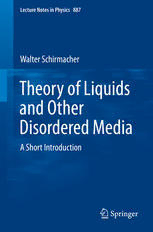Table Of ContentLecture Notes in Physics 887
Walter Schirmacher
Theory of Liquids
and Other
Disordered Media
A Short Introduction
Lecture Notes in Physics
Volume 887
FoundingEditors
W.Beiglböck
J.Ehlers
K.Hepp
H.Weidenmüller
EditorialBoard
B.-G.Englert,Singapore,Singapore
P.Hänggi,Augsburg,Germany
W.Hillebrandt,Garching,Germany
M.Hjorth-Jensen,Oslo,Norway
R.A.L.Jones,Sheffield,UK
M.Lewenstein,Barcelona,Spain
H.vonLöhneysen,Karlsruhe,Germany
M.S.Longair,Cambridge,UK
J.-F.Pinton,Lyon,France
J.-M.Raimond,Paris,France
A.Rubio,Donostia,SanSebastian,Spain
M.Salmhofer,Heidelberg,Germany
S.Theisen,Potsdam,Germany
D.Vollhardt,Augsburg,Germany
J.D.Wells,Geneva,Switzerland
Forfurthervolumes:
http://www.springer.com/series/5304
The Lecture Notes in Physics
The series Lecture Notes in Physics (LNP), founded in 1969, reports new devel-
opmentsin physicsresearch and teaching-quicklyand informally,but with a high
qualityand the explicitaim to summarizeand communicatecurrentknowledgein
anaccessibleway.Bookspublishedinthisseriesareconceivedasbridgingmaterial
between advanced graduate textbooks and the forefront of research and to serve
threepurposes:
(cid:129)
to be a compact and modern up-to-date source of reference on a well-defined
topic
(cid:129)
to serve as an accessible introductionto the field to postgraduatestudents and
nonspecialistresearchersfromrelatedareas
(cid:129)
to be a sourceof advancedteachingmaterialfor specialized seminars, courses
andschools
Bothmonographsandmulti-authorvolumeswillbeconsideredforpublication.
Editedvolumesshould,however,consistofaverylimitednumberofcontributions
only.ProceedingswillnotbeconsideredforLNP.
VolumespublishedinLNParedisseminatedbothinprintandinelectronicfor-
mats,theelectronicarchivebeingavailableatspringerlink.com.Theseriescontent
isindexed,abstractedandreferencedbymanyabstractingandinformationservices,
bibliographicnetworks,subscriptionagencies,librarynetworks,andconsortia.
Proposalsshouldbe sent to a memberof the EditorialBoard, ordirectly to the
managingeditoratSpringer:
ChristianCaron
SpringerHeidelberg
PhysicsEditorialDepartmentI
Tiergartenstrasse17
69121Heidelberg/Germany
[email protected]
Walter Schirmacher
Theory of Liquids
and Other Disordered
Media
A Short Introduction
123
WalterSchirmacher
InstitutfuRrPhysikKomet331
UniversitaRtMainz
Mainz
Germany
ISSN0075-8450 ISSN1616-6361 (electronic)
LectureNotesinPhysics
ISBN978-3-319-06949-4 ISBN978-3-319-06950-0 (eBook)
DOI10.1007/978-3-319-06950-0
SpringerChamHeidelbergNewYorkDordrechtLondon
LibraryofCongressControlNumber:2014944752
(cid:2)c SpringerInternationalPublishingSwitzerland2015
Thisworkissubjecttocopyright.AllrightsarereservedbythePublisher,whetherthewholeorpartof
thematerialisconcerned,specificallytherightsoftranslation,reprinting,reuseofillustrations,recitation,
broadcasting,reproductiononmicrofilmsorinanyotherphysicalway,andtransmissionorinformation
storageandretrieval,electronicadaptation,computersoftware,orbysimilarordissimilarmethodology
nowknownorhereafterdeveloped.Exemptedfromthislegalreservationarebriefexcerptsinconnection
with reviews or scholarly analysis or material supplied specifically for the purpose of being entered
and executed on a computer system, for exclusive use by the purchaser of the work. Duplication of
this publication or parts thereof is permitted only under the provisions of the Copyright Law of the
Publisher’slocation,initscurrentversion,andpermissionforusemustalwaysbeobtainedfromSpringer.
PermissionsforusemaybeobtainedthroughRightsLinkattheCopyrightClearanceCenter.Violations
areliabletoprosecutionundertherespectiveCopyrightLaw.
Theuseofgeneraldescriptivenames,registerednames,trademarks,servicemarks,etc.inthispublication
doesnotimply,evenintheabsenceofaspecificstatement,thatsuchnamesareexemptfromtherelevant
protectivelawsandregulationsandthereforefreeforgeneraluse.
While the advice and information in this book are believed to be true and accurate at the date of
publication,neithertheauthorsnortheeditorsnorthepublishercanacceptanylegalresponsibilityfor
anyerrorsoromissionsthatmaybemade.Thepublishermakesnowarranty,expressorimplied,with
respecttothematerialcontainedherein.
Printedonacid-freepaper
SpringerispartofSpringerScience+BusinessMedia(www.springer.com)
ForLinda
“Whatis theuseofa bookwithoutpictures
orconversations?”
Lewis Carroll,Alice’s Adventuresin
Wonderland
Preface
Thephysicsofliquids,solutions,glasses,andmacromolecularmaterialscomprises
averylargeareaofphysicalresearch.Nowadaysthesefieldsgrowtogetherandform
therapidlyexpandingfieldofsoft-matterphysics,whichalsoincludestheinvestiga-
tionofcolloids,liquidcrystals,andbiologicalmaterials.Withinthelargescientific
communityofsoft-matterresearchtheliquidand/ormacromolecularmaterialsare
investigated mostly with physicochemical experimental techniques and by means
of computersimulations. The latter method has in the last 50 yearsgrown from a
part of theoretical physics into what is now called computer experiment, because
the simulation data are analyzed in the same fashion as experimental data. The
only differencebetween simulationaland experimentaldata is that the underlying
equation of motion (Newton’s or Schrödinger’s equation) is known, but that is in
principlealso thecase fortheexperiment.Oneadvantageof thesimulationisthat
modelsystemscanbestudied,whicharesimplerthantherealmaterials.Anotheris
thatmicroscopicinformationcanbeobtained,whichisoutofscopeofexperiments.
However, a theoretical understanding of the behavior of complex materials
requires more than the knowledge of the underlying microscopic equations of
motions. Therefore theoretical concepts on a macroscopic level are required. A
numberofsuchconceptsarepresentedintheselecturenotes.
The present lecture notes arose from two courses: “Theory of Liquids and
Polymers I and II,” held at the institute for functional materials (Prof. W. Petry
and Prof. P. Müller-Buschbaum, E13) at the Physics Department of Technische
Universität München in the academic year 2006/2007. The aim of these courses
was to create a mutual understanding and a common theoretical language among
studentsandscientistsworkinginthisinstituteonsuchdifferentsubjectsasliquid
metals,glasses,polymers,andbiologicalmaterials.Thehandoutspresentedatthese
coursesformedthebackboneofthepresentlecturenotes.
The division of the notes into structure/thermodynamics and dynamics arises
from the fact that in classical systems (i.e., materials in which quantum effects
are notdominant)the structuralandthermalpropertiescan be studiedwithoutthe
knowledgeof the dynamics. On the other hand, the dynamicsof a liquid or other
soft-mattermaterialisstronglydependentonitsstructure.
ix

